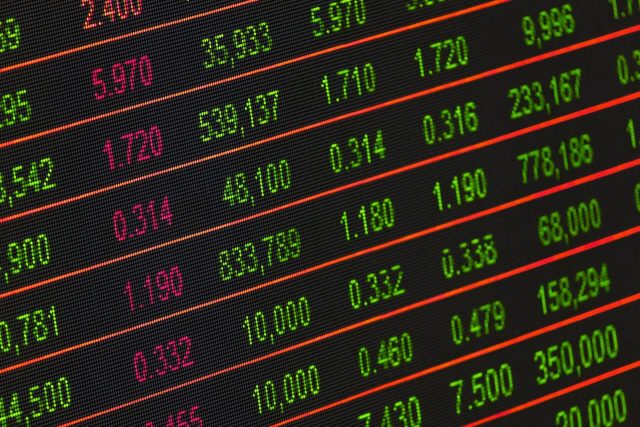
Equity investment can be broadly divided into “growth investment” and “value investment” depending on the investment policy. If you do not understand these differences, you will not be able to determine your own axis, and it will be difficult to earn profits, and there is also the risk of making losses.
Understanding the difference between growth and value investing is important to avoid situations like the one above. However, for those who are just starting to invest in stocks, it may not be easy to understand the differences between the two, indicators to refer to, and specific stocks.
Therefore, in this article, we will focus on growth investment, which is one of the methods of stock investment, and explain the overview, the difference from value investment that is often compared, and the advantages and disadvantages. We will also introduce notable indicators and representative growth stocks that are important for identifying growth stocks, so please refer to them.
table of contents- Growth investment is an investment method for “growth stocks”
- Advantages of growth investment, difference from value investment
- Advantages of growth investment
- Disadvantages of growth investment
- How to identify growth stocks, 3 indicators to watch for growth investment
- Examples of representative growth stocks that are ideal for growth investment
- High returns on growth stocks targeted for growth investment
1. Growth investment is a method of investing in “growth stocks”

Growth investment is a method of investing in stocks that are performing well and are expected to grow. Even if the current stock price is not that high, we will invest in companies that are developing groundbreaking services and services that are likely to generate large profits in the future.
In many cases, the stock price is expensive because of the expectations of investors, but if the company grows as expected, it is possible to obtain a large return.
As I will introduce in detail later, indicators such as “ROE (return on equity)”, “sales growth rate”, and “market capitalization” are important for identifying growth stocks for growth investment.
2. Advantages of growth investment, difference from value investment

Value investing is often compared with growth investing. Value investing is the practice of investing in undervalued stocks that are priced below their intrinsic value. Growth investment and value investment are two extreme investment methods, and there are differences in “investment target companies” and “how to generate profits”.
Next, I will explain the difference between each and how to use them.
2-1. Companies targeted for investment
Growth investment and value investment differ in the companies they invest in.
Companies targeted for growth investment are those with rapid growth in sales and profits. GAFAM
is a representative company. All of them are IT companies that emerged in the 2000s, and Mercari, Inc., and others in Japan fall into this category. In this way, many of the companies targeted for growth investment tend to deal with IT/technology and cutting-edge technologies.
Value investing, on the other hand, is a method of investing in companies whose stock prices are estimated to be lower than their intrinsic value. Many of the industries targeted for value investment are the financial industry and the manufacturing industry, but the main reason for this is that the market has matured to some extent and profits are stable.
*Acronym for Google (Alphabet), Apple, Facebook (Meta Platforms), Amazon, and Microsoft.
2-2.Profitability is different
Growth investment and value investment are also different in how to make profits.
The main way to make a profit in growth investment is “capital gain (profit obtained by selling the assets you own)”.
For example, if you buy a stock at 100,000 yen and sell it at 150,000 yen, you can get a capital gain of 50,000 yen. Companies targeted for growth investment can be expected to rise in stock prices because of their high growth rates, and the attractive point is that they can aim for large returns through capital gains.
On the other hand, value investment invests in relatively stable and undervalued stocks, so it can be said that it is characterized by the ability to aim for “income gain (profit obtained through holding assets)” in addition to capital gain. For example, if you own 1 million yen worth of stock and the dividend yield is 5%, the annual income gain is 50,000 yen.
2-3. Proper use of both
In order to use growth investment and value investment properly, it is important to keep track of the differences in the companies targeted for investment and the differences in how they generate profits. On top of that, in order to use growth investment and value investment properly, let’s clarify the purpose of your own operation.
Growth investment, which invests in growth companies, is suitable for investors who want to obtain large returns through capital gains. However, since the risk of a stock price decline is also high, it is essential to conduct a detailed company analysis and determine the growth rate.
On the other hand, value investment, which is investment in undervalued stocks, is suitable for investors who want to obtain a steady return while reducing risk.
Next, we will introduce the benefits of growth investment in detail.

3. Advantages of growth investment
There are several advantages to growth investment, but I will explain two of the most typical ones: “large returns can be expected” and “suitable for both long-term and short-term investments”.
3-1. Large returns can be expected
As I briefly mentioned at the beginning, one of the benefits of growth investment is that you can expect a large return. Growth investments target stocks in sectors and companies with above-average returns and rapid earnings growth.
On the other hand, due to the high volatility, there are cases where the stock plunges in the blink of an eye if bad news appears. In other words, growth investment can be said to be a particularly “high-risk, high-return” method among stock investments.
In fact, Apple, a representative growth stock, had a stock price of about $ 4.5 in June 2007 when the iPhone was sold, but as of May 2023, it has exceeded $ 170, about 15 years It has increased more than 38 times.
3-2. Suitable for both long-term and short-term investment
Another advantage is that growth investments are suitable for both long-term and short-term investments.
Growth stocks tend to rise in price over the long term. If you hold a long position during that time, unrealized gains will increase as the stock price rises.
On the other hand, although volatility is high, price movements are more stable than cryptocurrencies. Therefore, there is not much need to check the chart many times a day. If you want to aim for a high return, but don’t want to be overwhelmed by price fluctuations, it would be a good idea to incorporate growth stocks into your portfolio as part of your long-term investment.
Growth investments are also suitable for short-term investments.
The reason is that there are cases where the stock price rises sharply in a short period of time. Growth stocks have the potential for a momentary rise in stock prices when an announcement is made that will be a tailwind for business results, or when an increase in net income is revealed in the financial results. Growth stocks can also be an option for investors who want to profit from short-term trading.

4. Disadvantages of growth investment
So far, I have explained the merits of growth investment, but there are also demerits such as “income gain tends to be small” and “stock prices are often expensive”. Let’s take a closer look at each.
4-1.Tend to have less income gain
Growth investments tend to have less income gains such as dividends. This is because growing companies tend to use profits for capital investment, investment in new businesses, and business expansion rather than returning profits to shareholders.
As a result, capital gains from rising stock prices are the main way to earn profits from growth investments, and profits from income gains cannot be expected. Therefore, investors who want to continuously obtain stable income gains should consider investing in high-dividend value stocks.
4-2. Stock prices are often overpriced
In many cases, growth stocks are relatively expensive because the expectations of investors are reflected in the stock price.
Here, “PBR (Price Book Value Ratio)” and “PER (Price Earnings Ratio)” are the mainstream indicators to measure whether the stock price is undervalued or overvalued. PBR measures the adequacy of the stock price by calculating “How many times the stock price is the net asset per share” and PER “How many times the stock price is the net income per share”.
Keep in mind that growth stocks generally tend to outperform market averages when calculated based on the above metrics.
Growth stocks are often overvalued and have risks, so it is important to check the financial status of the company and invest in a diversified manner.

5. How to identify growth stocks, 3 indicators to watch for growth investment
- In growth investing, it is important to identify growth stocks. Here are four metrics to look for growth stocks:
- ROE (return on equity)
- EPS (Net earnings per share)
- Sales growth rate
market capitalization
We will explain each indicator in detail.
5-1.ROE (return on equity)
ROE (Return on Equity) is an index calculated by “net income / equity x 100”, and it is possible to grasp how much profit a company is making based on equity capital. For example, if equity capital obtained by issuing stock is 50 million yen and net income is 10 million yen, ROE is 20%.
If the ROE is high, it can be judged that the company is making good use of its equity capital. An ROE of 10% to 15% or more should be the standard for growth stocks.
However, since a company may use not only its own capital but also borrowings as business funds, it is important to compare with other companies in the same industry and consider liabilities while using this as a reference only.
5-2.EPS (Net income per share)
Earnings per share (EPS) can be calculated by dividing net income by the total number of shares outstanding, and is an index that shows how much profit is generated per share.
The higher the EPS, the higher the company’s profit, so surplus funds can be actively invested in new businesses and business expansion. Since EPS can also be used to estimate the future growth rate of a company, it is an important indicator for identifying growth stocks.
5-3.Sales growth rate
Sales growth is also an important indicator when determining whether a stock is a growth stock. The sales growth rate is calculated by “(sales in the current period – sales in the previous period) / sales in the previous period x 100”.
In the case of growth stocks, sales have increased in most cases compared to the past few years, so let’s focus on the sales growth rate. By comparing the sales growth rate with that of the same industry, it is possible to understand how much the company is growing.
5-4. Market capitalization
Market capitalization is also an indicator that can be used to determine whether a stock is a growth stock. Most of the companies with large market capitalization are large companies, and you can not expect the stock price to increase several times.
On the other hand, in the case of companies with a small market capitalization, there are many expectations for future growth rates, and in some cases, the stock price doubles, triples, or even more than 10 times.
However, even with growth stocks, there are companies with a large market capitalization, such as Tesla and Mercari, so it is better to regard it as an indicator that can judge whether it is a growth stock. It is important to consider it in combination with ROE, EPS, and sales growth rate.

6. Examples of typical growth stocks suitable for growth investment
So far, we have looked at the benefits of growth investing and the metrics that are important for finding growth stocks. From here, we will introduce examples of representative growth stocks that are considered optimal for growth investment as of late February 2023, both domestically and internationally.
6-1.Domestic growth stocks
Let’s take a look at three domestic growth stocks: Mercari, Tokyo Electron, and Cyber Security Cloud.
6-1-1. Mercari
In Japan, the familiar flea market app “Mercari” is attracting attention as a growth stock. In addition to the flea market app, it is a company that operates a wide range of businesses, including the operation of the smartphone payment service “Merpay” and the crypto asset and blockchain-related service “Mercoin”.
Compared to the pre-Corona stock price, 2021 is about four times as much, but the stock price has fallen sharply since the first half of 2022.
However, considering the speed of new business initiatives, overseas expansion, and the fact that a recovery trend can be seen from the second half of 2022, it is a stock that can be expected to grow in the future.
6-1-2. Tokyo Electron
Tokyo Electron is a company that develops and manufactures semiconductor manufacturing equipment and FPDs (flat panel displays). With the world’s third largest share in the semiconductor manufacturing sector, it is attracting attention in recent years as the demand for semiconductors is increasing.
As of March 2022, ROE is 36.86% and the sales growth rate is 43.2%, showing significant growth.
Demand for electronic devices such as smartphones and personal computers is inexhaustible, so Tokyo Electron, which is mainly engaged in semiconductor manufacturing, can be expected to continue growing in the future.
6-1-3.Cyber Security Cloud
Cyber Security Cloud is a company that develops AI and develops cyber security services.
ROE for the fiscal year ending December 2022 is 27.43%, and the sales growth rate for the fiscal year ending December 2021 is approximately 52%, and for the fiscal year ending December 2022 is approximately 43%.
With the promotion of remote work and DX (digital transformation), the importance of cyber security is increasing. We have great expectations for the future growth of the cyber security cloud, which utilizes the world’s leading cyber threat intelligence and AI technology.
6-2.Overseas growth stocks
We will explain three overseas growth stocks: “Tesla”, “NVIDIA” and “Raytheon Technologies”.
6-2-1.Tesla
Tesla is an electric vehicle (EV) manufacturer that develops and sells electric vehicles and related products, headquartered in California, USA. Elon Musk, who has great influence in the cryptocurrency market, is the CEO, and the company holds a large amount of Bitcoin as assets, so it is known as a company that is familiar to cryptocurrency investors.
As for stock price trends, in April 2023, the company announced that it had recorded a 24% decline in profit in the first quarter of the same year, temporarily dropping to around $160. However, it has since recovered and is hovering around $230 as of early June 2023.
6-2-2.NVIDIA
NVIDIA is a semiconductor manufacturer based in California, USA. As a pioneer in visual computing, we have driven the semiconductor market in industries such as gaming and data centers for over 20 years. Many of the supercomputers that are also used for training artificial intelligence algorithms use NVIDIA chips, and in recent years have also been developing automatic driving systems.
The stock price continued to decline from the end of 2021 to the latter half of 2022, and at one point fell to nearly $100. However, it has recovered significantly since then, and as of early June 2023, it is hovering around $400.
Although the company already boasts a top-class market share in the industry, further growth can be expected in the future as artificial intelligence and self-driving technology spread.
6-2-3.Raytheon Technologies
Raytheon Technologies is an aerospace and defense company headquartered in Virginia, USA. It consists of four departments: “Aerospace Parts”, “Aero Engines”, “Software/Cyber” and “Defense”.
In November 2022, it was announced that the US Department of Defense had ordered six missiles worth $1.2 billion from Raytheon Technologies for military support to Ukraine.
The military industry is one of the industries that supports the United States, and is an area where demand rises when the world situation becomes unstable. Stock prices are likely to fluctuate greatly depending on future geopolitical trends.

7. High returns on growth stocks targeted for growth investment
Stock investment can be divided into “growth investment” and “value investment” depending on the investment policy. It is important to know the difference between each to make a profit and reduce the risk of making a loss.
Growth investments are suitable for both long-term and short-term investments, in addition to obtaining large returns through capital gains. It is also a good idea to challenge growth investment within the range of acceptable risk.
When identifying growth stocks, please use the ROE (return on equity), EPS (net income per share), sales growth rate, and market capitalization introduced in this article as reference indicators. 
nhttps://imgs.coinpost-ext.com/uploads/2023/06/growth-investment-640×336.jpg –>
The post What is “growth investment” that invests in growth stocks? appeared first on Our Bitcoin News.

 2 years ago
146
2 years ago
146














 English (US) ·
English (US) ·